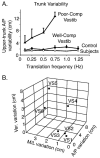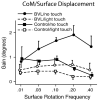Postural compensation for vestibular loss and implications for rehabilitation
- PMID: 20086283
- PMCID: PMC2965039
- DOI: 10.3233/RNN-2010-0515
Postural compensation for vestibular loss and implications for rehabilitation
Abstract
Purpose: This chapter summarizes the role of the vestibular system in postural control so that specific and effective rehabilitation can be designed that facilitates compensation for loss of vestibular function.
Methods: Patients with bilateral or unilateral loss of peripheral vestibular function are exposed to surface perturbations to quantify automatic postural responses. Studies also evaluated the effects of audio- and vibrotactile-biofeedback to improve stability in stance and gait.
Results: The most important role of vestibular information for postural control is to control orientation of the head and trunk in space with respect to gravitoinertial forces, particularly when balancing on unstable surfaces. Vestibular sensory references are particularly important for postural control at high frequencies and velocities of self-motion, to reduce trunk drift and variability, to provide an external reference frame for the trunk and head in space; and to uncouple coordination of the trunk from the legs and the head-in-space from the body CoM.
Conclusions: The goal of balance rehabilitation for patients with vestibular loss is to help patients 1) use remaining vestibular function, 2) depend upon surface somatosensory information as their primary postural sensory system, 3) learn to use stable visual references, and 4) identify efficient and effective postural movement strategies.
Figures



Similar articles
-
Recovery times of stance and gait balance control after an acute unilateral peripheral vestibular deficit.J Vestib Res. 2016;25(5-6):219-31. doi: 10.3233/VES-150561. J Vestib Res. 2016. PMID: 26890423
-
Short-term retention effect of rehabilitation using head position-based electrotactile feedback to the tongue: influence of vestibular loss and old-age.Gait Posture. 2013 Sep;38(4):777-83. doi: 10.1016/j.gaitpost.2013.03.018. Epub 2013 Apr 25. Gait Posture. 2013. PMID: 23623605
-
Postural strategies associated with somatosensory and vestibular loss.Exp Brain Res. 1990;82(1):167-77. doi: 10.1007/BF00230848. Exp Brain Res. 1990. PMID: 2257901
-
Posture in otoneurology. Volume I.Acta Otorhinolaryngol Belg. 1990;44(2):55-181. Acta Otorhinolaryngol Belg. 1990. PMID: 2251926 Review.
-
The linear vestibulo-ocular reflex, locomotion and falls in neurological disorders.Restor Neurol Neurosci. 2010;28(1):91-103. doi: 10.3233/RNN-2010-0507. Restor Neurol Neurosci. 2010. PMID: 20086286 Review.
Cited by
-
The role of neuromuscular changes in aging and knee osteoarthritis on dynamic postural control.Aging Dis. 2013 Jan 15;4(2):84-99. Print 2013 Apr. Aging Dis. 2013. PMID: 23696951 Free PMC article.
-
Interaction between Vestibular Compensation Mechanisms and Vestibular Rehabilitation Therapy: 10 Recommendations for Optimal Functional Recovery.Front Neurol. 2015 Jan 6;5:285. doi: 10.3389/fneur.2014.00285. eCollection 2014. Front Neurol. 2015. PMID: 25610424 Free PMC article. Review.
-
Real sounds influence postural stability in people with vestibular loss but not in healthy controls.PLoS One. 2025 Jan 24;20(1):e0317955. doi: 10.1371/journal.pone.0317955. eCollection 2025. PLoS One. 2025. PMID: 39854326 Free PMC article. Clinical Trial.
-
A pilot study on the evaluation of postural strategies in young and elderly subjects using a tridimensional electromagnetic system.Braz J Otorhinolaryngol. 2013 Mar-Apr;79(2):219-25. doi: 10.5935/1808-8694.20130038. Braz J Otorhinolaryngol. 2013. PMID: 23670329 Free PMC article.
-
Analysis of Ankle sEMG on Both Stable and Unstable Surfaces for Elderly and Young Women-A Pilot Study.Int J Environ Res Public Health. 2019 May 1;16(9):1544. doi: 10.3390/ijerph16091544. Int J Environ Res Public Health. 2019. PMID: 31052391 Free PMC article.
References
-
- Inglis JT, Macpherson JM. Bilateral labyrinthectomy in the cat: effects on the postural response to translation. Journal of Neurophysiology. 1995 Mar;73(3):1181–91. - PubMed
-
- Horak FB. Adaptation of automatic postural responses. In: Bloedel J, Ebner TJ, Wise SP, editors. Acquisition of Motor Behavior in Vertebrates. MIT Press; Cambridge: 1996. pp. 57–85.
-
- Horak FB, Nashner LM, Diener HC. Postural strategies associated with somatosensory and vestibular loss. Exp. Brain Res. 1990;82:167–177. - PubMed
-
- Buchanan JJ, Horak FB. Vestibular loss disrupts control of head and trunk on a sinusoidally moving platform. J. Vestibular Res. 2001-2002;11(6):371–89. - PubMed
-
- Creath R, Kiemel T, Horak F, Jeka JJ. Limited control strategies with the loss of vestibular function. Exp. Brain Res. 2002;145(3):323–33. - PubMed
Publication types
MeSH terms
Grants and funding
LinkOut - more resources
Full Text Sources
Medical

